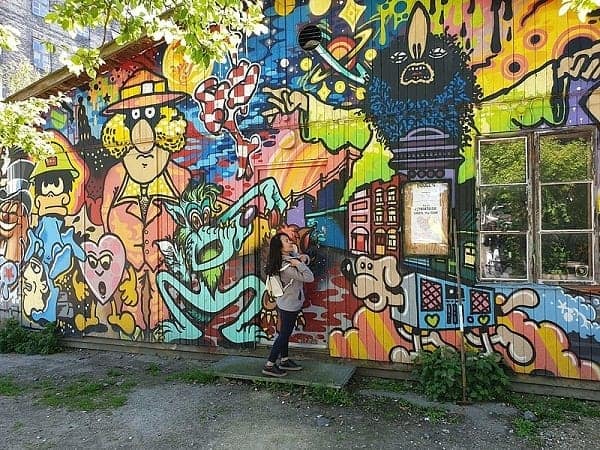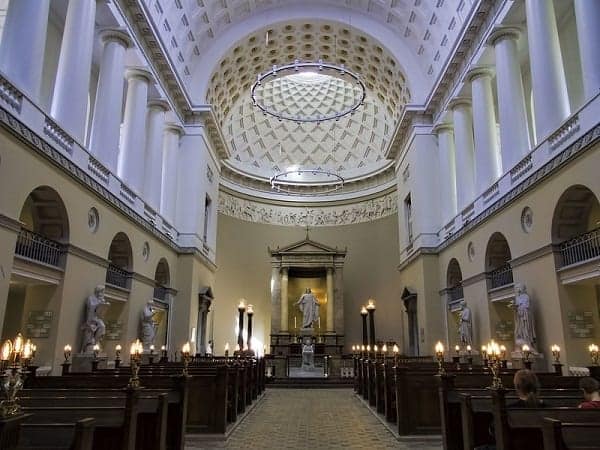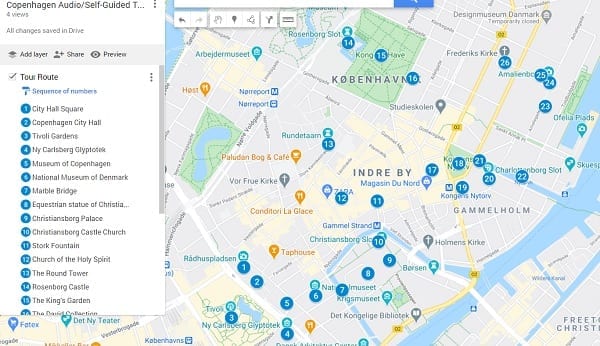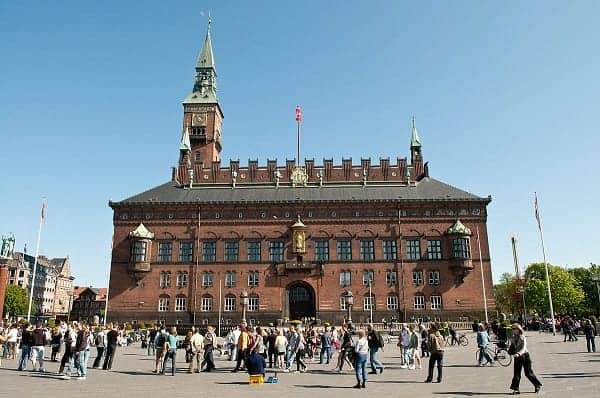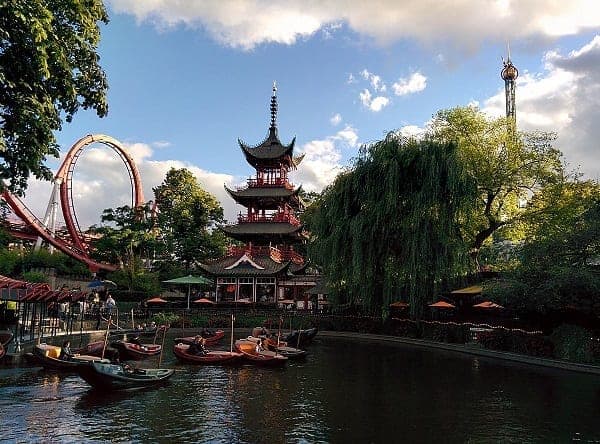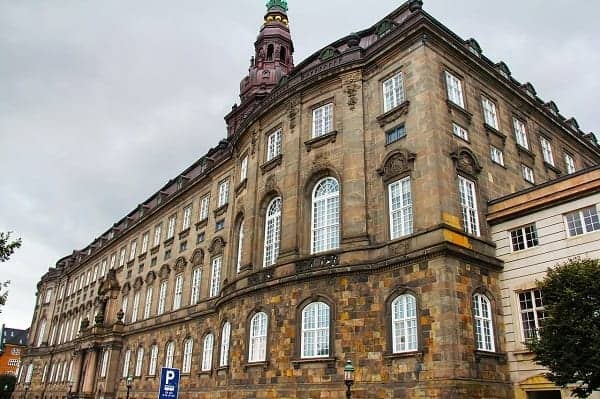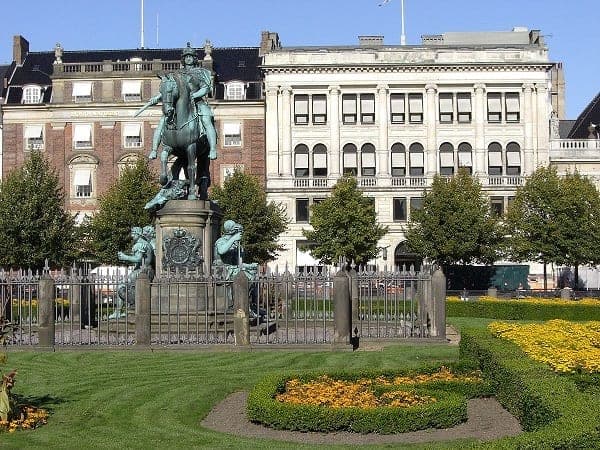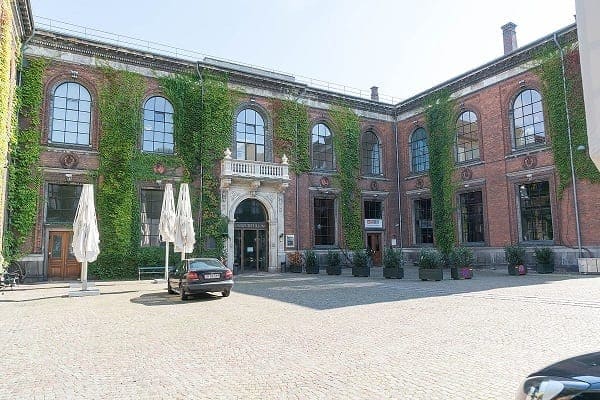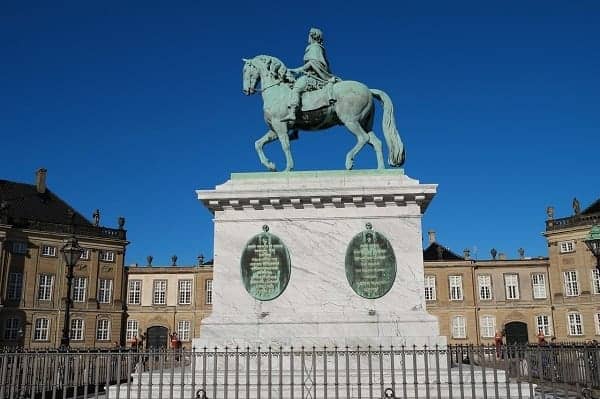This post lists the best Copenhagen free walking tours you can take when visiting the capital of Denmark.
We show you free walks of the city center, Christianshavn, notable locations related to the Renaissance, as well as pub crawls.
There are a few different free walking tours available in Copenhagen that cover a variety of subjects and historic locations in the city.
City center tours are the most common, and you can expect these services to include both historic and notable locations in Copenhagen.
The tours listed below are run through us. More tours are available in the following sections.
Searching Availability...
Here is a calendar with more of the best free walking tours in Copenhagen.
We even offer our own free, self-guided tour of the city center.
Some companies may also provide tips about the best restaurants, shops, and other attractions you may want to visit in the area.
If you’re more interested in seeing another side of the city, there are also tours covering Christianshavn, a historically Bohemian neighborhood that is considered by many to be the “alternative” district of Copenhagen.
There are also tours that cover the most historic aspects of the city, with a specific focus on Renaissance architecture and landmarks.
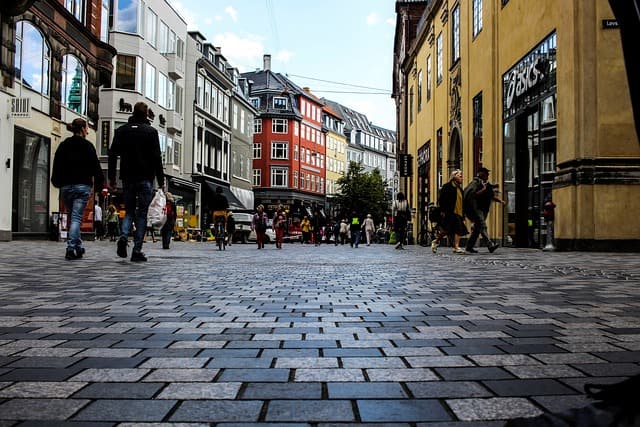
Free walking tours are technically pay-what-you-like tours. Instead of paying an upfront cost, you can pay the guide what you thought the tour was worth at the end.
This means these tours are very popular and affordable and attract large crowds.
So, for travelers who want to ensure an experience with smaller groups of people, we recommend paid small-group tours.
- Overview + Schedule
- City Center
- Christianshavn
- Renaissance Sites
- Pub Crawls
- Boat Tours
- 3-Day Itinerary
Alternatively, you may also want to consider a self-guided exploration game all about fairy tales and legends if you're looking for an outing your children might enjoy.
TIP: Take the popular hop-on-hop-off bus tour through Copenhagen for an easy mode of transportation that can help you cover more ground than you would while walking.
COPENHAGEN CITY CENTER TOURS
There are a lot of interesting things to see and experience in Copenhagen, including a variety of historic and cultural landmarks.
Each of the city center tours listed below is often referred to as a classical tour, as they cover the historic core of the city.
In addition to sightseeing, you can also expect to learn a lot about the golden age of arts in this city, with an emphasis on architecture, famous authors, and more.
Nyhavn Harbour
Attractions on these Copenhagen city center free walking tours:
- Rådhuspladsen
- Christiansborg Palace
- Amalienborg Square
- Marble Church
- Nyhavn Harbour
- Copenhagen Cathedral
- The Round Tower
- Little Mermaid
- And more!
If you’re interested in learning more about these locations, consider taking one of the following pay-what-you-wish walking tours or our self-guided version below.
Dinturia Tours
This company offers a daily, highly-rated walking tour of the city center called The Wonders of Copenhagen.
This tour is available daily at 10 a.m.
Searching Availability...
Copenhagen Guided Tours
Here you'll find a twice daily tour of the city center called Grand Copenhagen.
Discover the enchanting story of Copenhagen, a jewel at the Baltic's edge, transforming from a quaint fishing village into Denmark's vibrant capital. This city, shaped by battles against fire, plague, and invasion, stands today as a beacon of culture and creativity. Copenhagen is celebrated worldwide as a cradle of design, a playground for culinary aficionados, and a realm woven from fairy tales.
Embark on our Grand Tour to unravel the magic behind Copenhagen's rise to glory. Delve into tales of its visionary founder, uncover where to indulge in the finest Danish smørrebrød, and discover why the Danes are known as the happiest people on Earth!
This tour is available daily at 10:30 a.m. and 3:00pm.
They also offer the Christianshavn tour below!

Reservations are required. Book your tour or learn more.
Politically Incorrect Tours
This company takes a different approach to tours, providing a more humorous look at the history of Copenhagen as you discover some of the most notable sites in the city.
As the name implies, they won't pull any punches on this outing.
This tour is available daily at 11 a.m.
A reservation is required. Book your tour or learn more.
CHRISTIANSHAVN FREE WALKING TOURS
This bohemian neighborhood is somewhat off the beaten path, allowing you to get a look at a side of the city that few tourists ever experience.
While you’re traveling around the alternative district of Copenhagen, you’ll learn about its origins dating back to the 17th century as well as the history of the area.
Freetown Christiania
Attractions on this Christianshavn free walking tour:
- Hojbro Plads
- Absalon Statue
- Christianshavn Canal
- Church of Our Saviour
- Freetown Christiania
- And more!
If these locations sound interesting, you can learn more about all of them by taking the following pay-what-you-wish walking tour.
Christianshavn Free Walking Tour
This tour will give you the opportunity to discover one of the more interesting neighborhoods in all of Copenhagen.
Running daily at 15:00 (3 pm), this tour lasts for approximately 1 ½ hours.
One of the more interesting stops on this tour is in Freetown Christiania, a community that is seen as a state within another state.
There are only about 1,000 citizens living in Freetown, but they consider themselves outside of both Danish and EU law.
In addition to their Christianshavn service, this company also offers free walking tours of the city center and notable Renaissance landmarks.
Reservations are required. Book this tour or learn more.

COPENHAGEN RENAISSANCE FREE WALKING TOURS
Although the city center tours are a great way to learn about a variety of historical sites in Copenhagen, this tour is specifically focused on notable Renaissance landmarks and attractions.
Whether you’re interested in this time period or you just want to see some of the best architecture in the city, this free walking tour is definitely worth consideration.
Church of Our Lady
Attractions on the Renaissance tours:
- Rundetaarn
- Hojbro Plads
- Church of Our Lady
- Rosenborg Castle
- King’s Garden
- Torvehallerne market
- And more!
If you’re interested in seeing locations such as these, consider the free walking tour listed below.
Renaissance Copenhagen Free Tour
Discover some of the most notable Renaissance landmarks in the city on this 1 ½ hour Copenhagen tour which is offered every Thursday and Sunday at 12 pm.
This tour actually ends at a marketplace with several food stalls, which is the perfect place to get some delicious Danish pastries if you’re hungry at the end of the outing.
Don’t forget that this company also offers a free Copenhagen city center tour and a free Christianshavn tour.
Reservations are required. Book the tour or find out more.
COPENHAGEN PUB CRAWLS
There aren’t currently any free pub crawls offered in Copenhagen, but that could change in the future.
That said, there are some paid services you might want to consider.
Although you’ll have to pay for a ticket to enjoy a pub crawl, it’s worth noting that most of these outings include at least a few free drinks and access to drink specials.
Prices typically range in price from 130 - 150 DKK, and you can find some of the best options on this list of Copenhagen pub crawls.
COPENHAGEN SELF-GUIDED TOUR
This self-guided tour of Copenhagen will cover some of the most notable landmarks in the city center, providing details about important locations such as Rosenborg Castle, Christiansborg Palace, Charlottenborg Palace, Amalienborg Palace, and more.
You may also want to consider an audio tour or a pay-what-you-want option, as both of these services are also either free or affordable.
Click the map to enlarge it or to download it to a smartphone.
City Hall
This is the headquarters of the municipality and Lord mayor of Copenhagen, and the current building was first inaugurated in 1905.
The architectural style on display ii National Romantic, but it was also partially inspired by the Siena City Hall.
One of its most notable features is a gilded statue of Absalon above the balcony and clock tower.
Speaking of which, the clock on display here is Jens Olsen’s World Clock, an astronomical clock that tracks both lunar and solar eclipses, the positions of stellar bodies, and a perpetual calendar in addition to telling the time.
In addition to serving as the home of the municipal council, City Hall Square is also a popular location for concerts and celebrations every year.
There are a few interesting things to see in this square, including the Dragon Fountain, a statue of Hans Christian Anderson, and the Lur Blowers bronze monument which towers to the left of City Hall.
Tivoli Gardens
This is the second oldest amusement park in the world that is still operating to this day, and it first opened in 1843.
In addition to being such a historic location, it’s also the second most popular seasonal theme park in the world.
The original founder of Tivoli was Georg Carstensen, and he received a charter to create the amusement park by convincing King Christian VIII that “when people are amusing themselves, they do not think about politics.”
The earliest attractions here included a theatre, flower gardens, bandstands, a scenic railway, and simplistic amusement rides like a merry-go-round.
Tivoli originally hired Hans Christian Lumbye to compose music for their park, and his music was inspired by the works of the Strauss family, which garnered him the title “Strauss of the North.”
They still play his music to this day.
Over the years, Tivoli has brought in several new amusement park rides including the Rutschebanen, one of the oldest wooden roller coasters in the world.
Christiansborg Palace
This is the seat of the Danish Parliament. The building also serves as the Danish Prime Minister's Office and the Supreme Court of Denmark.
Since it serves so many purposes, this is technically home to the three supreme powers of the Danish political system: the executive branch, the legislative branch, and the judicial branch.
This is the only building in the world to house all three branches of government.
The building before you today is actually the third of its name, with two others being constructed on this exact site since 1167.
As a result of the different palaces constructed here, there are three eras of Danish architecture on display including Baroque, Neoclassicism, and Neo-baroque.
The equestrian statue in front of Christiansborg Palace depicts Christian IX. It was designed by Anne Marie Carl-Nielsen, wife of composer Carl Nielsen.
If you’re interested in seeing the interior, there are tickets available for the various buildings comprising the palace.
Even if you don’t feel like spending any extra money, you can visit the Christiansborg Castle Church for free on your way toward our next stop.
It’s also worth noting that access to the viewing platform in the Tower is entirely free to access, and this is the tallest tower in the city, offering some of the best views of Copenhagen.
Rosenborg Castle
This is actually one of the newer castles in Copenhagen, built in 1606 as a country summerhouse.
It’s also one of the finest examples of the Dutch Renaissance style of architecture.
Rosenborg Castle was originally used as a royal residence until the early 1700s.
While it has been used for that purpose two other times since then, the last time was in 1801.
This castle now houses a museum that exhibits the Royal Collections, which are artifacts from throughout the history of royal Danish culture from the 16th - 19th century.
This is also where you’ll find the Crown Jewels and Danish Crown Regalia, the coronation chair, the coronation carpet, the throne, and many other notable items.
While it’s not free to enter Rosenborg Castle, it is free to enjoy arguably the best view of this historic building from the King’s Garden.
You can also spend some time walking around and enjoying the fountain, playground, and other areas.
King’s New Square
This public square is centrally located near many notable locations in Copenhagen, including our next three stops: the Royal Danish Theatre, the Charlottenborg Palace, and Nyhavn.
This is the largest public square in the city, and it was laid out by Christian V in 1670.
You'll find an equestrian statue in his honor at the center of King's New Square.
The foot of the plinth has four statues depicting Alexander the Great, Minerva, Herkules, and Artemisia.
These statues symbolize fortitude, prudence, strength, and honor.
At the time when this square was built, it was intended as part of a plan to expand the city, and the result was that the city center moved from the medieval area of Gammeltorv to this new location.
The old kiosk in this square was built in the Baroque Revival architectural style in 1913 and served as a telephone stand for some time before being transformed into a small cafe.
Royal Danish Theatre
Although this theatre was originally built in 1874, the theatrical company itself was founded in 1748, and it first served as the theatre of the king.
Today, this theater is open to the public and hosts a variety of performance art including opera, ballet, and orchestra.
This is the home of the Royal Danish Ballet and the Royal Danish Orchestra, the latter of which has existed in one form or another since 1448.
The Royal Danish Theatre can seat up to 1,600 people at a time, and ticket prices range from somewhat affordable to quite expensive.
Charlottenborg Palace
Built in 1677 in the Baroque architectural style, this was originally the home of Ulrik Frederik Glydenlove, an important general who led during the Scanian War.
Ulrik was the half-brother of Christian V, who donated the land to him. This was the first building on New King's Square.
Eventually, when Ulrik became too old to take care of the house by himself, he sold it to Queen Charlotte Amalie in 1700, and that's where the palace earned its current name.
When Charlotte Amalie passed away in 1714, ownership of the palace was handed down to Christian VI, who would have a small theatre added to the residence.
Even before that, the Academy of Arts began using this palace for its activities in 1701, and the school would eventually be formally inaugurated in 1754.
Later on, in 1787, ownership of the palace was officially handed down to the Royal Danish Academy of Art, which still occupies the Charlottenborg Palace to this day.
Nyhavn
This district of Copenhagen is one of the most photographed locations in the world, as it is lined with bright and colorful 17th-18th century townhomes that make for an excellent photo opportunity.
Author Hans Christian Anderson lived here in Nyhavn for 18 years of his life.
Fans of his work should definitely take a moment to look around and take in the view that likely inspired the great writer for many years.
Due to its accessibility by boat, this area was also frequented by fishermen and ships carrying various cargo, making it a fairly important economic location.
Over the years, Nyhavn developed a reputation thanks to its many bars serving beer and drinks to sailors and prostitutes.
That said, as ocean-going ships got larger, fewer came to port in Nyhavn, and thus there weren't as many sailors, and the reputation of the area slowly faded.
Today, this area is mostly a popular tourist destination for anyone who wants to snap a picture of themselves with the perfect background imagery.
Amalienborg Palace
This is the home of the Danish royal family.
Although it was originally built in 1750 for four noble families, it would eventually be purchased by the royal family, who have resided here for over 200 years.
The design of Amalienborg follows the Rococo architectural style.
There is an equestrian statue of the founder of the palace buildings, King Frederick V, at the center of the square.
The four palaces that make up Amalienborg are named after some of its former residents: Christian VII's Palace, Christian VIII's Palace, Frederick VIII's Palace, and Christian IX's Palace.
Amalienborg is guarded 24/7 by the Royal Life Guards who march every day at 11:30 am from Rosenborg Castle to Amalienborg to perform the changing of the guard.
This is also the site of Amaliehaven, a two-level garden with several beautiful sculptures and a central fountain.





